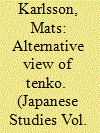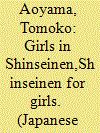| Srl | Item |
| 1 |
ID:
112850


|
|
|
|
|
| Publication |
2012.
|
| Summary/Abstract |
In discussions on tenko (political re-orientation) the case of Hayashi Fusao is invariably referred to as representative of the type of writer who never recanted his political conversion, not even after Japan's war defeat and return to democracy in 1945. Hayashi officially disavowed his Marxist convictions in 1936 and would for the rest of his life reiterate his rightist political leanings, culminating in his infamous In Affirmation of the Greater East Asia War. When considering Hayashi's tenko, critics usually rely on his various statements referring specifically to his re-orientation, coupled with an examination of his shift away from proletarian literature in serious works of fiction such as Youth (1934). In contrast, this article is an attempt to comment on Hayashi's purported conversion by focusing on samples of his rarely discussed popular writings that were published in the lowbrow youth literature magazine Shinseinen. This focus on Hayashi's predilection for adventurous storytelling aims to moderate the conventional image of him as a political thinker.
|
|
|
|
|
|
|
|
|
|
|
|
|
|
|
|
| 2 |
ID:
112849


|
|
|
|
|
| Publication |
2012.
|
| Summary/Abstract |
Although Shinseinen is generally regarded as a magazine for young men, girls and young women made a significant contribution to it as writers, readers, and protagonists. One of the key contributors to the popular representations of young women in Shinseinen is Hisao Juran (1902-1957). This paper focuses on two early comic novels Juran serialised in Shinseinen soon after his return from Europe. In Nonsharan dochuki [The Record of Nonchalant Travels] (1934), the 'nonchalant' girl heroine, Tanu ('racoon'), and her partner, Konkichi ('fox'), travel extensively in France, becoming involved in a series of slapstick nonsense and surrealistic events and accidents. In Fyugu doree [The Golden Fugue] (1935) the same pair are caught up in a search for secret funds by representatives of various international crime syndicates. Both texts employ comic pedantry that involves cross-cultural and multilingual knowledge and sophistication. Notably, in Juran's texts the comic elements tend to be assigned to women and girls. I will link this to Takahara Eiri's notion of the 'consciousness of the girl' and Tsurumi Shunsuke's interpretation of Ame no Uzume as a brave, subversive, and inclusive being. I will also cite Nakano Miyoko's parody of Juran as a tribute to the freedom espoused in his nonsense slapstick pedantry.
|
|
|
|
|
|
|
|
|
|
|
|
|
|
|
|